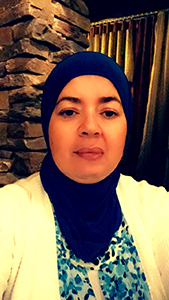August 2021 Featured Educator: Kifah Soheil

Some people were never quite certain who they wanted to be when they grew up. And some people, like Kifah Soheil, knew who they wanted to be when they were in kindergarten.
Kifah, an English language (EL)/bilingual elementary teacher at Ridge Central School in Chicago Ridge, Illinois, was born and raised in Palestine. At 15 years old, she got married and moved to the U.S., where she continued to pursue her kindergarten-old dream of becoming a teacher.
High up on her list of things to do to become a teacher in the U.S. was to develop good English language skills. Kifah’s native language is Arabic, so she started to learn English through social interactions, watching television and helping her children with their homework.
“I went back to school after my youngest child went to fifth grade,” Kifah said. “I began with English as a Second Language (ESL) classes at Moraine Valley Community College. Then, I earned my GED diploma. Next, I earned my associate degree, and after that, I earned my bachelor's degree in education from Trinity Christian College.”
Since then, she’s been teaching at Ridge Central School where she’s held many positions including district liaison, co-coordinator of the EL program and EL team leader. In that time, she also earned a master's degree in leadership.
“What I love about my job is getting up every morning to meet my goal of the day which is to teach my students a new concept or idea to increase their English language skills,” she said. “I love exploring different cultures to understand and accept the values, behavior, practices and celebrations of each culture.”
Ridge Central School is in the southwest suburbs of Chicago and serves more than 500 students in PreK through fifth grade. Arabic is the predominant language spoken at Ridge Central School, with high numbers of students speaking Spanish and Polish. The school is a Title I school: all students receive free breakfast and lunch.
Kifah's classroom represents a diverse group of learners. One of her priorities is creating a classroom environment that is safe and welcoming, inclusive, respectful and has a high level of peer-to-peer interaction.
“Students tend to show success when they are engaged in the learning process,” Kifah said. “I create lesson plans that are enjoyable to students, to produce effective learning. Addressing the joy in planning and learning should be focused on as much as planning for and meeting individual learning goals.”
To ensure that her students have the same access to content learning as their English-speaking peers, Kifah collaborates with general education teachers.
“The Can Dos are always shared with general education teachers so they can understand each student's language level and abilities in the four domains of language,” she said. “I collaborate with content area teachers by having a common plan period… focused on students' academic and language abilities/levels. Cooperating with content area teachers is a key to success in learning the second language.”
When it comes to encouraging her students to learn, Kifah said she makes sure to incorporate native languages into her lesson plans.
“I love when I see the look on my students' faces when they make connections between their native language and the English language to understand the content or concepts,” Kifah said.
In her lessons, she relies on comprehensible input, which is what she said is “the most effective strategy or method.” Comprehensible input helps ensure she is giving clear explanations, using appropriate speech and differentiating instruction. She gives students ample opportunity to engage with their peers and likes to use teacher modeling to increase verbal communication and to provide feedback to students.
“I believe knowing and acknowledging your students' learning styles is crucial to the success of learning a second language,” she said. "I believe that all methods and strategies are useful to promote language and academic learning when they are presented through comprehensible input and real-life topics, hands-on activities and the use of realia*.”
Not surprisingly, Kifah’s passion for helping students learn English doesn’t stop in her classroom. She teaches adult English classes for her bilingual families and runs family nights that promote literacy and culture.
“We have a strong bond between the bilingual families and the school community,” Kifah said. “I am a strong believer of families being in a partnership with their children's educational journey.”
As for her own family, Kifah is happily married with four children and two grandchildren.
“I believe education is the foundation of a successful life. I implemented my beliefs in my children,” she said.
Kifah’s eldest daughter graduated from Moraine Valley Community College as a respiratory therapist, her second eldest graduated from Saint Xavier University with a degree in nursing, her third eldest is a successful business manager and her youngest graduated from Chicago State University with a Ph.D. in pharmacy.
“Education is very important to me, and I hope my children continue to implement this belief with their future families,” Kifah said. “I encourage every English language learner to never give up and to continue to follow their dreams.”
*Merriam-Webster defines realia as “objects or activities used to relate classroom teaching to the real life especially of peoples studied.”





